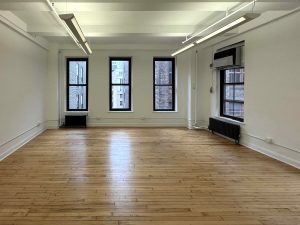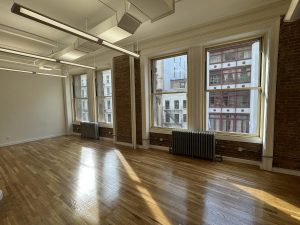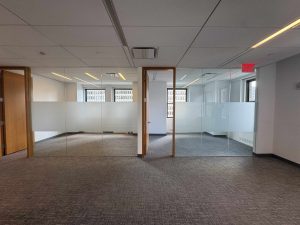I used to field calls asking, “Will companies ever bring people back?” Now every conversation starts with “Did you hear who just announced five days?” And it’s all because companies, of different shapes, sectors, and sizes, are essentially declaring the end of remote work.
The speed of this shift is surprising. In NYC alone, I’m tracking mandates from JPMorgan, Goldman, Amazon—major employers across finance, tech, consulting, retail. They’re all pulling the trigger on full-time office requirements, and they’re doing it now.
This end of remote work is hitting my clients’ decisions in real time. That surplus of sublease space? Shrinking fast. Pricing on good floors in decent buildings? Moving up. Suddenly, when I submit offers on spaces that have sat empty for months, I’m frequently running into competing offers from other tenants trying to rightsize, dump space, or lock something down.
The gist of it is you need to know who’s mandating the return to office (RTO) and how fast, because when companies with thousands of employees all need desks again at once, it changes the entire game. The market dynamics are shifting under our feet, and the pace is only picking up.
The End of Remote Work Era: Corporate Return-to-Office Mandates by Industry
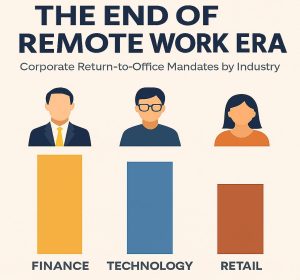
Let me break down exactly who’s mandating returns and when, because keeping track of these end of remote work announcements feels like a full-time job in itself.
Finance Leads the Charge (And Nobody’s Surprised)
Wall Street never really bought into the whole remote thing anyway. JPMorgan has had senior managers back five days a week since April 2023, and now they’re eyeing company-wide mandates. Goldman Sachs keeps citing “compliance and mentorship” while pushing everyone back full-time.
And the dominos keep falling. Citigroup pulled its 600 remote workers back to offices. HSBC and Barclays went straight to five days. Even BMO joined the party, announcing four days starting September 2025.
The kicker? FINRA regulations gave banks the perfect cover. New rules require residential work locations to be registered and inspected, which basically translates to “too much paperwork, everyone back to your desks.”
Tech Giants Do a Complete 180
Remember when tech companies bragged about permanent remote work? Yeah, about that. Amazon dropped the hammer in January 2025—five days, no exceptions. Meta tracks attendance daily for their three-day mandate. Dell told sales teams to get back five days a week starting March 2025.
The irony isn’t lost on anyone. X (formerly Twitter) once championed remote work, but now demands 40 hours onsite. Apple enforces three days with “disciplinary measures” for non-compliance.
Even the companies that still allow some flexibility—Google, Salesforce—expect regular office presence.
Everyone Else Falls in Line
AT&T brought everyone back full-time in January 2025, claiming better customer service. Starbucks upped its requirement to four days under its new CEO. Ford Motor Company will jump to four days starting September 2025 on account of “transformation” and “efficiency.”
Other retailers are getting aggressive, too. Chipotle went from three to four days for corporate staff. Sweetgreen tightened requirements at its NYC headquarters. Best Buy reversed their remote-friendly stance entirely. Boots went straight to five days a week for office staff—no messing around.
What It Means for Office Demand
All these return-to-office mandates translate into real market movements that affect every lease negotiation, renewal decision, and space strategy I’m seeing. The data points paint a picture of a market transforming in real time—and not always in predictable ways.
Office Attendance Rebounds, But Unevenly
Manhattan’s averaging 57% daily office attendance—that’s 76% of pre-pandemic levels and climbing. Recent data shows that law firms led the charge with a 25% year-over-year jump in office attendance, while finance and media companies posted 20% gains. Real estate firms hit 85% attendance, practically back to the 2019 normal.
What’s striking is how Manhattan outpaces other metros. We’re only 5.5% below April 2019 foot traffic, while San Francisco and LA lag 30-44% behind their peaks. Over half of Fortune 100 companies now mandate full-time office presence, and only 8% of Manhattan workers remain fully remote. A softer job market gave employers the leverage they needed—turns out RTO mandates stick better when alternative opportunities dry up.
Leasing Activity Signals Confidence
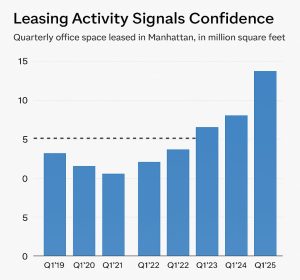
Q1 2025 delivered 12.2 million square feet in leasing—the strongest showing since 2019. The deals tell the story: Jane Street’s 400,000-square-foot expansion at 250 Vesey, Universal Music’s 334,000 square feet at Penn 2, Deloitte’s massive 800,000-square-foot commitment at 70 Hudson Yards.
Midtown office space availability dropped to 14.9%, with trophy buildings below 12% citywide. Prime Midtown locations show availability under 7.5%. Hudson Yards and Plaza District command $160 per square foot, with select deals exceeding $200. Finance, law, and private equity firms drive this premium demand—their higher in-office presence directly correlates with their appetite for top-tier space.
Quality Becomes the Dividing Line
The flight-to-quality phenomenon intensified beyond anyone’s predictions. Tenants now view Class A buildings as recruitment and retention tools, not just office space. Modern infrastructure, upscale amenities, and prestige locations like Midtown and Hudson Yards see overwhelming demand.
Landlords face a choice: invest heavily in upgrades or explore alternative uses. The city’s conversion incentives already sparked plans for 17,400 residential units from former office buildings. Trophy properties command premium rents while older assets struggle to compete. The market’s message is clear—mediocre space at any price struggles to find takers when premium options exist.
A Market Split in Two
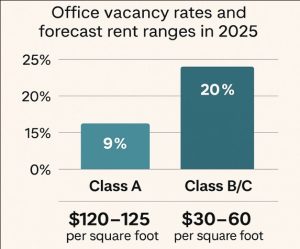
The numbers reveal a tale of two markets. Class A trophy buildings maintain sub-10% vacancy while Class B and C properties exceed 20%. Trophy rents project $120-125 per square foot for 2025. Class B and C buildings settle for $30-60 per square foot when they can find tenants at all.
Non-Class A buildings shed 43 million square feet of occupied space—a staggering exodus. Large corporations pursuing RTO strategies want premium environments for their mandated workforce. Smaller, cost-conscious tenants might consider Class B space but balk at outdated infrastructure and empty floors. Concession packages grow increasingly desperate, with some landlords offering unprecedented free rent periods to secure any occupancy.
Politics as Usual
A potential Zohran Mamdani mayoral administration introduces competing forces into an already complex market. Higher corporate taxes, aggressive office-to-residential conversion plans, and small business support create uncertainty for institutional owners. Midtown and Downtown Brooklyn face particular conversion pressure.
Yet Manhattan maintains the nation’s strongest leasing performance and lowest vacancy, according to CoStar. The contradiction is clear as day—corporate mandates drive demand while political forces aim to shrink supply. Demolitions and conversions outpace new development, 23.3 million to 12.7 million square feet.
Sure, employees continue pushing back against RTO policies. Yet, resistance weakens as economic realities set in. Federal mandates add another layer of complexity.
And as this all plays out, institutional investors watch nervously while opportunistic players eye potential arbitrage. Tenants and landlords each have skin in the game here. Timing and building selection are more important than ever in this politically charged, economically driven market transformation.
Next Steps as a Tenant: Your RTO Action Checklist
The market’s moving fast, and waiting for perfect clarity means missing opportunities. Whether you’re expanding, contracting, or just trying to make sense of your options, here’s your roadmap for making smart moves as the widespread end of remote work becomes a reality.
- Audit Your Actual Headcount (Not Your Wishful Thinking): Stop guessing how many people will show up—start counting who’s actually coming in. Track badge swipes, survey your teams, and factor in your company’s RTO trajectory. If you’re mandating four days but planning for two, you’ll either waste money on empty desks or scramble for space when reality hits.
- Chase Quality Buildings, Not Just Good Deals: That bargain Class B space looks tempting until your top talent refuses to commute for fluorescent lights and broken elevators. Premium buildings with real amenities aren’t luxuries anymore—they’re recruitment and retention tools. Your employees compare their office to their living room now, so make sure you win that comparison.
- Negotiate Like the Market’s Still Uncertain (Because It Is): Push for maximum flexibility in lease terms, expansion/contraction rights, and termination options. Secure hefty tenant improvement allowances—landlords need you more than they’ll admit. Get everything in writing about sublease rights and assignment provisions, because your five-year plan might change in five months.
- Lock In Space Before Your Competitors Do: Quality inventory moves faster than ever, especially in Midtown’s sub-15% availability market. If you find space that works, move quickly—the days of leisurely six-month searches are over. Set up tours now for Q4 and Q1 2026 moves, because waiting means competing with every other company finally executing their end of remote work plans.
- Plan for Political Curveballs: Factor in potential tax changes, conversion risks, and neighborhood transformations under the new administration. Buildings targeted for residential conversion might offer short-term deals but long-term headaches. Consider lease provisions that protect against municipal changes, and don’t assume your building will remain commercial forever in this political climate.
The End of Remote Work: Your Window Is Narrowing
Call it what it is: the end of remote work in NYC. Banks, tech firms, retailers—everyone’s scanning badges, writing five‑day policies, and locking in long leases. The pendulum swung back, and it’s not wobbling.
Here’s what that means if you’re a tenant: true Class A space is getting picked off while landlords pump millions into upgrades. The offers on the table today won’t sit there by Q4. When the end of remote work drives bodies back, quality space moves first.
So move with intent. Lock the space that fits where your company is headed. Hard‑wire flexibility—expansion rights, contraction options, sublease language—because surprises keep coming.
The market’s about to split cleanly. Trophy towers will have waitlists and trophy rents. The rest will either convert, reinvest heavily, or stare at empty lobbies. The end of remote work isn’t a forecast; it already rearranged the furniture.
Let’s make sure your strategy keeps up.






